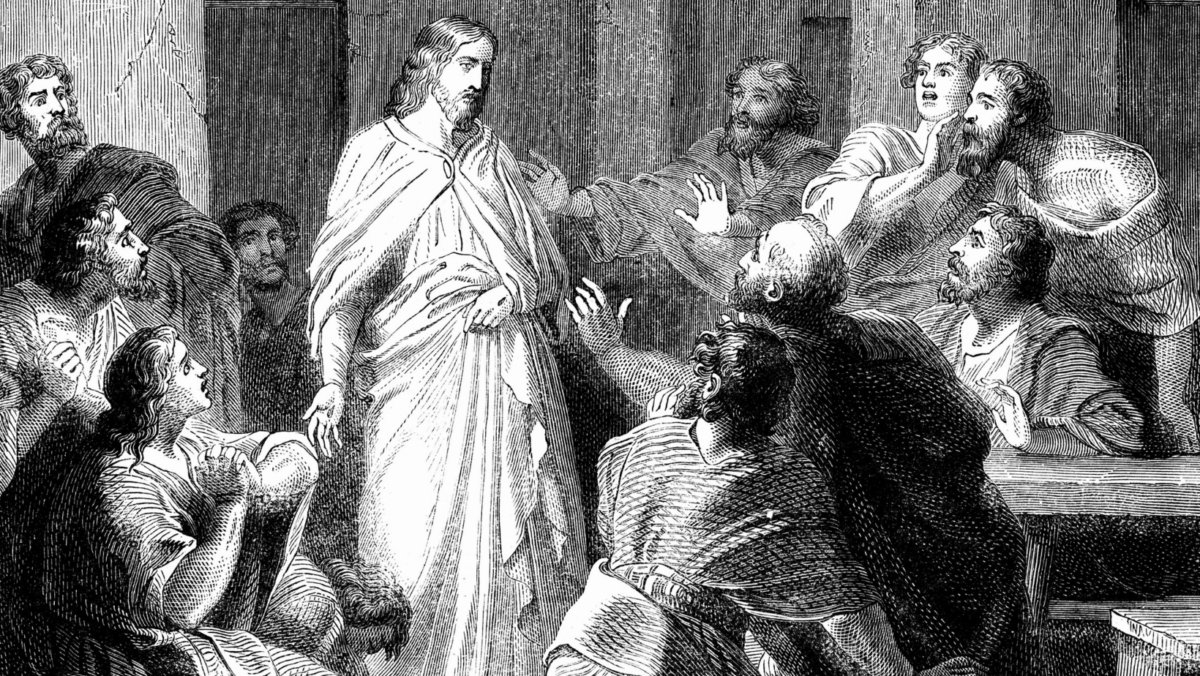THE GHOST AND THE PROMISE
Luke 24:36b-48
Third Sunday of Easter, Year B
Analysis by Matt Metevelis
36While they were talking about this, Jesus himself stood among them and said to them, “Peace be with you.” 37They were startled and terrified, and thought that they were seeing a ghost. 38He said to them, “Why are you frightened, and why do doubts arise in your hearts? 39Look at my hands and my feet; see that it is I myself. Touch me and see; for a ghost does not have flesh and bones as you see that I have.” 40And when he had said this, he showed them his hands and his feet. 41While in their joy they were disbelieving and still wondering, he said to them, “Have you anything here to eat?” 42They gave him a piece of broiled fish, 43and he took it and ate in their presence.
44Then he said to them, “These are my words that I spoke to you while I was still with you – that everything written about me in the law of Moses, the prophets, and the psalms must be fulfilled.” 45Then he opened their minds to understand the scriptures, 46and he said to them, “Thus it is written, that the Messiah is to suffer and to rise from the dead on the third day, 47and that repentance and forgiveness of sins is to be proclaimed in his name to all nations, beginning from Jerusalem. 48You are witnesses of these things.
“Only a savior with flesh and blood who is able to share community with us can truly comfort us. Just as Christ must really be there on the cross to bear our sins Jesus must really be here among us to bear life.”
Author’s Note: For the purposes of this text study and for an explanation of what the witness of the disciples actually means you might want to add this extra verse to the pericope:
49And see, I am sending upon you what my Father promised; so stay here in the city until you have been clothed with power from on high.
DIAGNOSIS: He Gets Us
Step One: Initial Diagnosis (External Problem): No Peace
Jesus comes in the midst of the disciples and proclaims peace. But the disciples are terrified. Their feelings are the opposite of peace. Quite the opposite. Luke uses the same verb (pteomai) for the disciples reaction (v. 37) to describe an understandable reaction to warfare (21:9). At the announcement of peace from Jesus the disciples are startled, alarmed, and terrified. The resurrected Jesus has put them in an uproar.
In our day Jesus has made quite an appearance in our midst. A series of ads during the Super Bowl talked about the ministry and person of Jesus. “He Gets Us” says the campaign. Using images that pull on heart strings the campaign calls us to meet Jesus as one who gets our suffering, calls us to forgive, and to wash feet. Even though these messages might seem simple and non-controversial to most believers among Christians these ads provoked controversy. Conservative Christians claimed that the ads watered down the message of Jesus by promoting healing across the political divide and culture war flashpoints. Progressive Christians objected because many of the groups behind the ad were conservative Christians. And many echoed the disciples when they asked why millions of dollars couldn’t go to help the poor instead. As modern-day disciples we seem just as confused and affronted as the original ones. We are unable to hear Jesus’ call to peace and make him into a sign of division instead.
Step Two: Advanced Diagnosis (Internal Problem): The Ghost
The disciples are prevented from hearing Jesus by what they think they see. Jesus is a ghost or a phantasm to them. They only half-believe their eyes and see their teacher and friend as a shadowy form. When we try to conjure an image of Jesus from our own expectations, theories, and desires we likewise find Jesus as an unreal and unbounded presence in our lives. As Isaiah puts it “no ear has perceived, no eye has seen” (64.4).
This presence can be benevolent and reflect our best wishes. But more likely our own images of Jesus can conjure some deep fears. As Salmon Rushdie put it “ghosts mean unfinished business.” The disciples might have feared that Jesus came back in a way not unlike the shade of Samuel that Saul summoned only to have it accuse him. A bare Jesus without anything attached can only be a vague spirit signifying our fantasy or a threat pointing out our sins.
Step Three: Final Diagnosis (Eternal Problem): We Want You on Our Side
We try to deflect the threat that Jesus poses by making his form resemble something safe and familiar. That spectral form of Jesus becomes just a conduit for winning our battles and personal struggles. If Jesus “gets us” then he must be on our side and do us a solid every once in a while. As the 90s band Primitive Radio Gods put it:
“We sit outside and argue all night long
About a God we’ve never seen
But never fails to side with me.”
Jesus becomes less a savior and more a banner. For some he’s a folk hero who defends culture and nation against the forces of godlessness. For others he’s a humble community organizer who inspires us to resist systemic injustice. For many he’s a comforting presence who symbolizes love to adorn hearth and home. In all these ways people take the ghostly image of Jesus and form him into something which conforms with their pre-existing beliefs, hopes, and expectations. Instead of a savior we seek an ally. And we just won’t accept a Jesus concocted by our enemies. And maybe, truth be told, no one is on our side – not even God.
PROGNOSIS: We Get Him
Step 4: Initial Prognosis (Eternal Solution): For Us In Flesh
When Jesus tells his disciples that “it’s me” their joy is still mixed with doubt. The person of Jesus himself isn’t enough to build faith and drive out doubts and fears. Jesus still has to prove that he is real. Jesus, whether a spindly image with a smiley face or a dour presence on a crucifix, can only coddle or confront us. Only a savior with flesh and blood who is able to share community with us can truly comfort us. Just as Christ must really be there on the cross to bear our sins Jesus must really be here among us to bear life. The flesh and blood appearance of Christ is proof that we get him in our lives as a real person and not a phantom. If Jesus only “gets us” he can’t really help. A boss, a judge, or a spouse might “get us” too and that might be less than good news. Jesus comes among us always because we get him.
Step 5: Advanced Prognosis (Internal Solution): The Promise
And we get Jesus in a particular way. We don’t receive Jesus by our own imaginings or efforts. Instead Jesus comes to us clothed in God’s word. His time with the disciples is marked by “opening their mind to understand the Scriptures.” Jesus can be located in our particular story because of his exalted place in the universal story. He’s not a symbol of our side but the place where all our battles stop and cease so that he might be all in all. We’re called not to claim Jesus but to be claimed by him via “repentance and the forgiveness of sins.” Jesus is not a prisoner to our mind’s image. Jesus becomes real when we know not his form but his benefits. Jesus is God’s promise in the flesh right near us so that we can’t miss it. We are not meant to conceive him but receive him.
Step 6: Final Prognosis (External Solution): “Witness to These Things”
Jesus does not just say “peace” to the disciples he also embodies it. He carries in his body the very scars and wounds of their fears and divisions. At the table with Jesus the disciples are changed from refugees from the cross into witnesses of the resurrection. They are empowered to carry this Jesus into the world so that hearts and minds can be changed (repented) and sins are forgiven. It’s no longer a model of attracting people to Jesus in their sufferings or most noble ideals as in the “He Gets Us” campaign. The disciples now will carry that forgiveness to every nation and through every tongue. This transformation is one that we make every time we hear the gospel.
(Spoiler alert.) Recently I watched the new Alexander Payne film “The Holdovers.” Paul Giammati is cast in this film as a crochety old history teacher in an exclusive boarding school with a lazy eye and a rare disease that makes him smell like fish. We learn in the film about the injustices in his own life that have made him resentful to both the administration of the school and its students. He seeks to inflict maximum pain on his charges by punitive grading and sharp insults because he judges them to be rich and entitled. Left alone during winter break with the student who exasperates him the most he is gradually changed by spending lonely time with him and the school cook who recently lost her son in Vietnam. Through this time acquainting himself with the sorrows of others he learns that suffering doesn’t know an income bracket and the “justice” he throws around isn’t building people around him up but tearing them down. He is changed around the student. He speaks him into freedom by telling him that he is more than his family’s struggles. At the end of the movie, transformed, he makes an uncalled for yet extremely noble sacrifice for the student in question. Having been asked before by the student which eye people should look into as he walks out of the headmaster’s office, he points to his good eye saying “it’s this one.”
I found this to be a profound image. When we enter that place of death and resurrection and fall and forgiveness as the true real estate where Jesus leaves we begin not only to see Jesus aright but we are finally able to look at one another. This is true peace, when our own suffering holds no fear for us and the suffering of others becomes real. We don’t just share a witness, we “bear” one. We don’t carry and bear just some words about Jesus but the actual redeeming witness of what Christ has done for us and for our neighbors. We bear one another in the arms of a savior who bore us “peace” becomes more than just a greeting. Peace through the promise we bear in our hearts, our lips, and our hand is the abiding gift of Christ.






You must be logged in to post a comment.